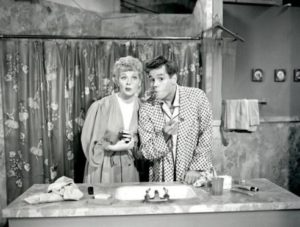
For millions of viewers around the world, I Love Lucy is an enduring symbol of classic comedy. Its slapstick humor, iconic characters, and universal themes of marriage and friendship have made it a timeless classic. But beneath the surface of the show’s sunny disposition and effortless comedic timing lies a story of rebellion, innovation, and a series of behind-the-scenes struggles that would surprise even the most dedicated fans. The secrets behind the show’s success reveal a series that was far ahead of its time, not only in its comedic genius but in its groundbreaking business and technical decisions that would shape the future of television.
The Technical Revolution: Desi Arnaz’s Genius
In the early 1950s, network television was still in its infancy, and most shows were broadcast live from New York City. The picture quality was often poor, and there was no way to create a high-quality rerun. When CBS approached Lucille Ball to bring her hit radio show, My Favorite Husband, to television, she had one non-negotiable demand: her real-life husband, Desi Arnaz, had to be her co-star. Network executives were skeptical of an American woman being married to a Cuban bandleader, a dynamic they feared audiences wouldn’t accept. But Arnaz and Ball were determined to make it work.
Arnaz, a shrewd businessman and innovator, proposed a radical solution to the network’s concerns. He convinced CBS to let them film the show in Los Angeles on high-quality 35mm film instead of broadcasting it live from New York. This was a costly endeavor, but Arnaz saw an opportunity that no one else did. In exchange for the network paying for the extra expense, Arnaz insisted that their production company, Desilu Productions, retain ownership of the films. This was a deal that would change television forever. It gave them the ability to sell reruns into syndication, a concept that was almost unheard of at the time. This move alone would make them television pioneers and moguls.
But Arnaz didn’t stop there. He and his cinematographer, Karl Freund, invented the multi-camera setup that is now the industry standard for sitcoms. Instead of using a single camera, they used three cameras positioned in a way that could capture every angle, allowing them to film the show in sequence and in front of a live audience. This method not only made production more efficient but also gave the show a more authentic and energetic feel. The live audience’s laughter, a staple of the show, was not a canned laugh track; it was the real, unfiltered laughter of a crowd that was there to witness television history in the making.
The Off-Screen Drama: A Turbulent Marriage and a Feud
While the on-screen antics of the Ricardos and the Mertzes were always filled with laughter and love, the off-screen reality of the cast was far more complex. The real-life marriage of Lucille Ball and Desi Arnaz was famously tumultuous, with reports of Arnaz’s infidelity and drinking. The show was in many ways an effort to save their marriage, giving them an opportunity to work together and be in the same city. The strain of their relationship was a constant presence, sometimes spilling into the production, but their undeniable love for each other and their shared commitment to the show’s success always brought them back.
The off-screen dynamic between the supporting cast members was just as dramatic. The on-screen chemistry between William Frawley (Fred Mertz) and Vivian Vance (Ethel Mertz) was legendary, a hilarious depiction of a bickering but loving couple. But in real life, the two famously disliked each other. Vance, who was 22 years younger than Frawley, resented having to play the wife of a man old enough to be her father. Frawley, who was also a famously cranky and gruff man, reportedly overheard Vance’s complaints and never forgave her. The two would often trade insults off-screen, with Frawley famously telling her, “She’s one of the finest girls to come out of Kansas, but I often wish she’d go back there.” The animosity between them, however, seemed to fuel their on-screen bickering, making their exchanges even more memorable and authentic.
Another fun fact is that William Frawley was a die-hard New York Yankees fan and even had a clause written into his contract that he could miss filming if the Yankees were in the World Series. This is a rare example of a TV star having that kind of power at the time.
A Legacy of Pioneering Moments
Beyond the technical innovations and the personal drama, I Love Lucy also broke new ground for television content. The show was the first to feature an interracial couple, a bold move for its time that was initially resisted by the network. It was also the first show to feature a pregnant lead actress, an unprecedented decision that was met with resistance from network censors. The word “pregnant” was forbidden, and the show instead used the more palatable phrase “expecting.” The storyline of Lucy’s pregnancy, which mirrored Lucille Ball’s real-life pregnancy with her second child, was a massive hit with viewers and a groundbreaking moment in television history.
The show’s ability to tackle controversial topics, from interracial marriage to pregnancy, while maintaining its comedic tone, was a testament to the creative genius of Lucille Ball and Desi Arnaz. They were able to push the boundaries of television and usher in a new era of programming that was both entertaining and culturally significant. The behind-the-scenes secrets of I Love Lucy reveal a show that was not only a pioneer but a creative and business powerhouse that forever changed the way television is made. Its legacy is not just in its laughter, but in the enduring lessons it teaches us about risk-taking, innovation, and the power of a good story.
